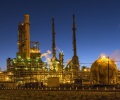The Middle East’s petrochemicals push signals oil’s future

This is the second installment in a three-part series exploring oil, plastics demand and sustainability.
Plastics and chemicals will account for the largest share of global crude demand growth by 2030, and a third wave of petrochemicals expansion underway in the Middle East is looking to cash in on the trend, as investment into downstream petroleum industries will become a critical demand driver for oil markets in the future.
Industrialized economies use up to 20 times more plastic and up to 10 times more fertilizer than developing nations on a per person basis, underscoring the huge potential for global growth. The International Energy Agency expects petrochemicals to account for almost half of global oil demand growth by 2050, equivalent to almost 7 million b/d.
However, chemicals and plastics have become dirty words for many consumers, with a growing international campaign gaining momentum to ban single-use products like bottles and cups. Despite the environmental backlash, particularly in Europe, Japan and South Korea, which have ramped up recycling efforts, S&P Global Platts Analytics expects demand for the material and other associated materials to remain on a growth trajectory.
“Petchems and plastics demand are highly correlated to population and GDP growth,” said Jennifer Van Dinter, Platts Analytics’ global head of NGL and petrochemicals. “The focus at present in the petchem market is targeting economic growth in China and India and bringing western development trends to those economies.”
Middle Eastern leaders
Middle East petrochemicals producers are racing to expand, and Saudi Arabia – already the region’s largest producer – is leading the charge. Last month Saudi Aramco unveiled a deal with France’s Total and Daelim of South Korea to build a new 80,000 mt/year polyisobutylene plant by 2024. The product is used for adhesives and lubricants.
The deal comes as Aramco pursues a tie-up with Saudi Basic Industries – the world’s third largest petrochemicals producer. Aramco and Total are also planning to construct a huge petrochemicals complex in Jubail, next to the SATORP refinery, utilizing 1.5 million mt/year of ethylene, key for plastic packaging. The state-controlled upstream giant is also working with Sabic on an another major project to convert crude oil to chemicals at Yanbu on the eastern Red Sea coast.
Abu Dhabi is also targeting significant petrochemical production growth. ADNOC is expanding its global refining and petrochemicals footprint, with plans to transform its main Ruwais facility into a sprawling integrated refining and petrochemicals complex.
Last year, the company said it aims to double crude refining capacity and triple petrochemicals production in a $45 billion investment drive alongside its partners. In Oman, the sultanate is investing heavily to create an integrated refining and petrochemicals hub in the port of Duqm outside the Persian Gulf.
The Duqm refinery—a joint venture between Kuwait Petroleum International and Oman Oil Company—includes a petrochemicals complex. The facility is expected to reach completion by 2023. The Duqm industrial zone, which aims to attract investments of up to $15 billion over the next 15 years, is Oman’s biggest single economic project and part of the sultanate’s efforts to diversify its economy away from oil export revenues.
State-owned Kuwait Petroleum Corporation is eyeing further expansion in petrochemicals. The company is mulling a potential fourth complex, called Olefins-4, to produce plastics. The project would add to KPC’s petrochemicals capacity on top of Olefins-3 and Aromatics-2, which are being built at the Al-Zour refinery. The 615,000 b/d Al-Zour refinery and petrochemicals complex in the south of the country is expected to come online in 2020 after years of delays.
The next wave
It is no longer just the Middle East banking on petrochemicals as the key source of oil demand growth. The US and now China are muscling in, with Deloitte saying availability of low-cost shale gas resulted in an unprecedented capacity creation and expansion in 2010-2017, primarily along the US Gulf Coast. And the next wave is imminent.
The Middle East, with an advantaged supply, and China and India, where there is strong demand, are “leading the way for oil-to-petchems refineries and projects,” Van Dinter said. “The North American petrochemicals complex has put significant investment dollars behind the ethylene value chain [which goes to making plastics among other products] in the form of ethane-fed steam crackers.”
Source: Platts

 Hellenic Shipping News Worldwide Hellenic Shipping News Worldwide, Online Daily Newspaper on Hellenic and International Shipping
Hellenic Shipping News Worldwide Hellenic Shipping News Worldwide, Online Daily Newspaper on Hellenic and International Shipping





















 PG-Software
PG-Software